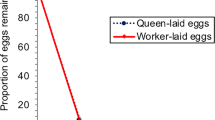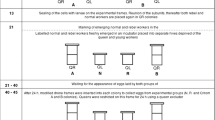Abstract
A hopelessly queenless honeybee colony has only one reproductive option: some workers must produce sons before the colony dies. This requires the workers to curtail egg policing (removal of worker-produced eggs), rendering the colony vulnerable to non-natal reproductive parasitism. In the Western honeybee, Apis mellifera, guarding (prevention of foreign workers from entering a colony) increases in queenless colonies, providing a defence against non-natal parasitism. However, in the closely related Eastern honeybee A. cerana, queenless colonies appear to be more tolerant of bees from other colonies. We presented guards of four A. cerana colonies with three types of workers: nestmate returning foragers, non-nestmate returning foragers and non-nestmates from a laying-worker colony. The latter are likely to have active ovaries, allowing us to test whether guard bees can detect which potential invaders are more likely to be reproductive parasites. After assessing guards’ reactions, we recaptured test bees and dissected them to determine levels of ovary activation. We found that nestmates were accepted significantly more frequently than the other two types of workers. However, there was no difference in the overall acceptance rates of non-nestmate returning foragers and bees from within laying-worker colonies. In addition, ovary-activated workers were no less likely to be accepted than those with inactive ovaries. Interestingly, colonies were more accepting of all three types of test bee after being made queenless. We conclude that, as has been previously suggested, guarding has no specific role in the prevention of non-natal parasitism in A. cerana.


Similar content being viewed by others
References
Arias M.C. and Sheppard W.S. 2005. Phylogenetic relationships of honey bees (Hymenoptera: Apinae: Apini) inferred from nuclear and mitochondrial DNA sequence data. Mol. Phyl. Evol. 37: 25-35
Beekman M., Calis J.N.M., Oldroyd B.P. and Ratnieks F.L.W. 2002a. When do honey bee guards reject their former nestmates after swarming? Insect. Soc. 49: 56-61
Beekman M. and Oldroyd B.P. 2008. When workers disunite: intraspecific parasitism by eusocial bees. Annu. Rev. Entomol 53: 19-37
Beekman M., Wossler T.C., Martin S.J. and Ratnieks F.L.W. 2002b. Parasitic Cape honey bee workers (Apis mellifera capensis) are not given differential treatment by African guards (A. m. scutellata). Insect. Soc. 49: 216-220
Birmingham A.L., Hoover S.E., Winston M.L. and Ydenberg R.C. 2004. Drifting bumble bee (Hymenoptera: Apidae) workers in commercial greenhouses may be social parasites. Can. J. Zool. 82: 1843-1853
Bourke A.F.G. 1994. Worker matricide in social bees and wasps. J. Theor. Biol. 167: 283-292
Buschinger A. 2009. Social parasitism among ants: a review (Hymenoptera: Formicidae). Myrmecol. News 12: 219-235
Butler C.G. and Free J.B. 1952. The behaviour of worker honey bees at the hive entrance. Behaviour 4: 262-292
Chapman N.C., Beekman M. and Oldroyd B.P. 2010. Worker reproductive parasitism and drift in the western honeybee Apis mellifera. Behav. Ecol. Sociobiol. 64: 419-427
Chapman N.C., Makinson J., Beekman M. and Oldroyd B.P. 2009a. Honeybee, Apis mellifera, guards use adaptive acceptance thresholds to limit worker reproductive parasitism. Anim. Behav. 78: 1205-1211
Chapman N.C., Nanork P., Gloag R.S., Wattanachaiyingcharoen W., Beekman M. and Oldroyd B.P. 2009b. Queenless colonies of the Asian red dwarf honey bee (Apis florea) are infiltrated by workers from other queenless colonies. Behav. Ecol. 20: 817-820
Chapman N.C., Nanork P., Reddy M.S., Bhat N.S., Beekman M. and Oldroyd B.P. 2008. Nestmate recognition by guards of the Asian hive bee Apis cerana. Insect. Soc. 55: 382-386
Clarke F.M. and Faulkes C.C. 2001. Intracolony aggression in the eusocial naked mole-rat, Heterocephalus glaber. Anim. Behav. 61: 311-324
Dampney J.R., Barron A.B. and Oldroyd B.P. 2002. Policing of adult honey bees with activated ovaries is error prone. Insect. Soc. 49: 270-274
Downs S.G. and Ratnieks F.L.W. 1999. Recognition of conspecifics by honeybee guards uses nonheritable cues acquired in the adult stage. Anim. Behav. 58: 643-648
Downs S.G. and Ratnieks F.L.W. 2000. Adaptive shifts in honey bee (Apis mellifera L.) guarding behavior support predictions of the acceptance threshold model. Behav. Ecol. 11: 326-333
Engel M.S. and Schultz T.R. 1997. Phylogeny and behavior in honey bees (Hymenoptera: Apidae). Ann. Entomol. Soc. Am. 90: 43-53
Erler S. and Lattorff H.M.G. 2010. The degree of parasitism of the bumblebee (Bombus terrestris) by cuckoo bumblebees (Bombus (Psithyrus) vestalis). Insect. Soc. 57: 371-377
Faulkes C.G., Abbott D.H. and Jarvis J.U.M. 1990. Social suppression of ovarian cyclicity in captive and wild colonies of naked mole-rats, Heterocephalus glaber. J. Reprod. Fert. 88: 559-568
Fowler J., Cohen L. and Jarvis P. 1998. Practical Statistics for Field Biology. John Wiley and Sons, New York
Free J.B. 1977. The Social Organization of the Honey Bees. Edward Arnold, London
Hölldobler B. and Wilson E.O. 1978. The Ants. Harvard University Press, Cambridge
Holmes M.J., Oldroyd B.P., Allsopp M.H., Lim J., Wossler T.C. and Beekman M. 2010. Maternity of emergency queens in the Cape honey bee, Apis mellifera capensis. Mol. Ecol. 19: 2792-2799
Jarvis J.U.M. 1981. Eusociality in a mammal - cooperative breeding in naked mole-rat colonies. Science 212: 571-573
Jordan L.A., Allsopp M.H., Oldroyd B.P., Wossler T.C. and Beekman M. 2008. Cheating honeybee workers produce royal offspring. Proc. R. Soc. Lond. B. 275: 345-351
Kupper G. and Schwammberger K.H. 1995. Parasitism in bumble bees (Hymenoptera, Apidae) - observations of Psithyrus sylvestris in Bombus pratorum nests. Apidologie 26: 245-254
Lo N., Gloag R.S., Anderson D.L. and Oldroyd B.P. 2010. A molecular phylogeny of the genus Apis suggests that the Giant Honey Bee of the Philippines, A. breviligula Maa, and the Plains Honey Bee of southern India, A. indica Fabricius, are valid species. Syst. Entomol. 35: 226-233
Lopez-Vaamonde C., Koning J.W., Brown R.M., Jordan W.C. and Bourke A.F.G. 2004. Social parasitism by male-producing reproductive workers in a eusocial insect. Nature 430: 557-560
Miller D.G. and Ratnieks F.L.W. 2001. The timing of worker reproduction and breakdown of policing behaviour in queenless honey bee (Apis mellifera L.) societies. Insect. Soc. 48: 178-184
Monnin T., Ratnieks F.L.W., Jones G.R. and Beard R. 2002. Pretender punishment induced by chemical signalling in a queenless ant. Nature 419: 61-65
Nanork P., Chapman N.C., Wongsiri S., Lim J., Gloag R.S. and Oldroyd B.P. 2007. Social parasitism by workers in queenless and queenright Apis cerana colonies. Mol. Ecol. 16: 1107-1114
Nanork P., Paar J., Chapman N.C., Wongsiri S. and Oldroyd B.P. 2005. Asian honeybees parasitize the future dead. Nature 437: 829
Oldroyd B.P., Halling L.A., Good G., Wattanachaiyingcharoen W., Barron A.B., Nanork P., Wongsiri S. and Ratnieks F.L.W. 2001. Worker policing and worker reproduction in Apis cerana. Behav. Ecol. Sociobiol. 50: 371-377
Oldroyd B.P. and Wongsiri S. 2006. Asian Honey Bees: Biology, Conservation and Human Interactions. Harvard University Press, Cambridge
Ratnieks F.L.W. 1988. Reproductive harmony via mutual policing by workers in eusocial Hymenoptera. Am. Nat. 132: 217-236
Ratnieks F.L.W. and Reeve H.K. 1992. Conflict in single-queen Hymenopteran societies - the structure of conflict and processes that reduce conflict in advanced eusocial species. J. Theor. Biol. 158: 33-65
Ratnieks F.L.W. and Visscher P.K. 1989. Worker policing in the honeybee. Nature 342: 796-797
Sakagami S.F. 1954. Occurrence of an aggressive behaviour in queenless hives, with considerations on the social organisation of honeybee. Insect. Soc. 1: 331-343
Tan K., Yang M., Radloff S., Pirk C.W.W., Crewe R.M., Phiancharoen M., Hepburn R. and Oldroyd B.P. 2009. Worker reproduction in mixed-species colonies of honey bees. Behav. Ecol. 20: 1106-1110
Visscher P.K. and Dukas R. 1995. Honey bees recognize development of nestmates’ ovaries. Anim. Behav. 49: 542-544
Wenseleers T., Alves D.A., Francoy T.M., Billen J. and Imperatriz-Fonseca V.L. 2011. Intraspecific queen parasitism in a highly eusocial bee. Biol. Lett. 7: 173-176
Wilson E.O. 1971. The Insect Societies. Harvard University Press, Cambridge
Acknowledgments
We thank Zhongwen Hu for his assistance in the field. This research was supported by an Endeavour Research Fellowship (MJH) and the Australian Research Council (MB and BPO).
Author information
Authors and Affiliations
Corresponding author
Rights and permissions
About this article
Cite this article
Holmes, M.J., Tan, K., Wang, Z. et al. Honeybee (Apis cerana) guards do not discriminate between robbers and reproductive parasites. Insect. Soc. 60, 265–271 (2013). https://doi.org/10.1007/s00040-013-0292-8
Received:
Revised:
Accepted:
Published:
Issue Date:
DOI: https://doi.org/10.1007/s00040-013-0292-8




